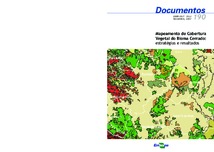Mapeamento de cobertura vegetal do bioma Cerrado: estratégias e resultados.
Mapeamento de cobertura vegetal do bioma Cerrado: estratégias e resultados.
Resumo: ABSTRACT: Mapping Cerrado's vegetation cover is difficult because of its geographical extemt (~ 204,7 million hectares), high seasonality, and high spatial and temporal dynamics of its land use activities. The objective of this study was to map the vegetation cover of the Cerrado biome in the 1:250,000 scale using Landsat satellite imageries from the year of 2002. The following classes of land use were considered: croplands, planted pasturelands, reforestations, urban settlements and mining areas. For natural vegetation classes, we used the Brazilian System of Vegetation Classification, developed by the IBGE - Brazilian Institute for Geography and Statistics. The methodological approach involved segmentation of the Landsat imagery, followed by the visual association of the resultant segments with thematic mapping classes of the study area. Based on such semi-automatic approach, we estimated a 61.5 % of natural vegetation cover in the Cerrado. This percentage varied greatly depending upon the region in this biome; from less than 10 % in the south to higher than 90 % in the north of Cerrado.
Ano de publicação: 2007
Tipo de publicação: Folhetos
Unidade: Embrapa Cerrados
Observações
1 - Por padrão são exibidas publicações dos últimos 20 anos. Para encontrar publicações mais antigas, configure o filtro ano de publicação, colocando o ano a partir do qual você deseja encontrar publicações. O filtro está na coluna da esquerda na busca acima.
2 - Para ler algumas publicações da Embrapa (apenas as que estão em formato ePub), é necessário ter, no celular ou computador, um desses softwares gratuitos. Sistemas Android: Google Play Livros; IOS: iBooks; Windows e Linux: software Calibre.
Acesse outras publicações
Acesse a Base de Dados da Pesquisa Agropecuária (BDPA) para consultar o acervo completo das bibliotecas da Embrapa.

